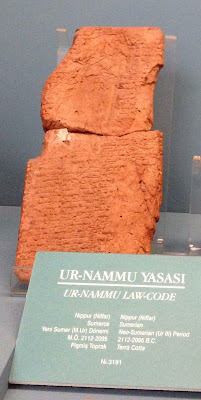Babasaheb Ambedkar and Mahatma Gandhi are the two of the great and famous freedom fighters of our country. But both of them had many differences. They had many disagreements and debates over the issue of casteism. Who was right? And who was wrong?
Dr Bhim Rao Ambedkar Popularly called Babasaheb Ambedkar, was born in the Mahar caste. Which is a Dalit caste. Since childhood, he had faced caste oppression. During his school days, his brother and he were the only Dalit students.They weren't allowed to drink water from the same tap in the school. The school had a special water pot for them, but they weren't even allowed to drink from it. The peon of the school would pour water out into their hands. Even after getting an education of this level, he faced caste discrimination in every aspect of his life.
So it isn't surprising that he despised discrimination and casteism. He hated them so much that not only he criticized the Hindus and those who practiced casteism and he also openly criticized the Hindu religion. He believed that as long as there is a caste, there will be an outcast. He wanted a complete annihilation of the caste system.
On the other hand, Mahatma Gandhi was a religious Hindu. Most of his principles and strategies were inspired by this religion. In fact, he considered the Gita to be his spiritual dictionary. And as a truly religious person, he respected all religions. And worked towards communal harmony. He believed that caste was a fundamental part of Hinduism. At the same time, he also believed that untouchability was not a part of Hinduism. He believed untouchability to be a sin for the Hindus. For this reason, in 1932 he founded the All India Anti Untouchability League.
You can see clear differences between the ideologies of Dr Ambedkar and Gandhi Ji. Gandhi Ji's initial views are often considered quite problematic. He was very orthodox and conservative. To the extent that Gandhiji didn't openly criticize Casteism.
In the 1920s he publicly stated that he didn't support intermarriage and inter-dining.
In 1932, he changed his opinion on inter-caste marriages. He acknowledged that he was wrong. He said that the restrictions on inter-caste marriages, were weakening the Hindu society.
In 1946 the situation was that Gandhi Ji had said that he wouldn't let men and women marry in his Ashram unless one of them was a Harijan. He also said that if he could, he would persuade all girls to find Harijan husbands.
On the other hand, in October 1935 in a conference, Dr Ambedkar had openly declared that he wants to leave Hinduism.And later, he converted to Buddhism.
Overall, the largest disagreement between Dr Ambedkar and Mahatma Gandhi was about separate electorates. Separate electorates mean that there would be such constituencies in the country where only a person of a specific community can run in an election. And only the people of the specific community would be able to vote.
Today, there are different constituencies. You vote in your constituency for your MP (Member of Parliament). All the residents of the constituency can cast their vote if they're above the age of 18. But in separate electorates, a specific community can cast their vote. Suppose Sikh or Muslim or Christian, candidate is running, then only the Sikh or Muslim or Christian people will be able to vote in their constituency. The others would not even be allowed to cast a vote.
Under British Raj, in 1909 British Government in India, had given Muslims separate electorates in India.
In 1919, the Christians, Anglo-Indians, Europeans and Sikhs were being given separate electorates in India.
Dr Ambedkar wanted separate electorates for the Dalits as well. But Gandhi Ji was absolutely against it.
During 1931's Round Table Conference in London, Gandhi Ji went there and put his demands in front of the British government. He said that the untouchables were also Hindus. They should not be given minority status. At the equivalent time, he also wanted that the separate electorates given to the Muslims, Christians, Sikhs and therefore the others, should be removed.
But on the opposite hand, Ambedkar wanted that the Dalits should even be declared minorities in India. They too should be given separate electorates.
The British government always used the policy of divide and rule.
In 1932, British Prime Minister Ramsay MacDonald, announced a Communal award. Not only did he say that the separate electorates given to the minorities would remain,they wouldn't be discontinued, he also said that the Dalits would also be a separate minority category and the Dalits would also be given separate electorates.
Gandhi Ji did not like it at all. Gandhi Ji believed that because of the separate electorates the country couldn't remain united. And he was willing to give up his life because of it. So Gandhi Ji started a fast. Fast unto death.
Dr Ambedkar was very pressurized because of this. On one hand, he wanted to get his demands fulfilled And on the other hand, he knew that if Gandhi Ji was actually harmed the image of the Dalits would also suffer.
Dr Ambedkar and Mahatma Gandhi then came to a historic agreement. Which is called the Poona Pact. Dr Ambedkar and Gandhi Ji compromised. Both of them decreased a rung and selected Joint Electorates.
What are joint electorates?
They are, basically, such constituencies where the elected politician would belong from a specific minority community. But when it involves to voting, all the residents of that constituency would be able to vote. The right to vote wouldn't be given to only one community.
Dr Ambedkar convinced Gandhi Ji of his demands.
Political agenda aside, talking about the social reforms, Dr Ambedkar contributed a lot to it. His strategy was very simple. Educate, Agitate and Organize.
A major example of this is the 1927 Mahad Satyagraha. In Maharashtra, there is a municipality Mahad. He went there with many followers to drink water. Seems very simple, but many upper-caste Hindus of the time were totally against it. The situation turned almost riotous and the police had to interfere. These upper-caste Hindus 'purified' the water tank with things like milk and curd.
On 25th December of an equivalent year, Dr Ambedkar and a lots of his followers started a campaign to burn the Manusmriti. Manusmriti is an ancient Hindu text where the caste rules are written. The day they did that, is celebrated as Manusmriti Dahan Divas.
Another famous movement was at Nashik's Kalaram Temple. The Dalits were forbidden to enter the temple. He started a procession march against it.
He was also inspired by the ideas of the French Revolution. Liberty, Equality and Fraternity. Not only did he mention these in the Constitution , but he also wrote them in the Preamble.
And he mentioned these in the Mahad Satyagrah as well. We often take these ideas for granted. But let's not forget, that these things it isn't so that every country had them in their constitution always.
Another huge achievement of Dr Ambedkar has been bringing in the Hindu Code Bill along with Pandit Jawaharlal Nehru. This was a very progressive step for Hindu women, which helps to protect them.
Unfortunately, at that time, it couldn't be brought in for the other religions because of tense situations. But the Uniform Civil Code, that is much talked about, Let's hope it brings such progressive reforms for every religion.
Today all of us could learn a lot from the ideas and ideologies of Dr Ambedkar. If we really want to pay tribute to him these principles of Liberty, Equality and Fraternity, should be implemented in the truest sense for all. Because all of us know that on the ground, we still can't see these today.
All of us know that even today how prevalent casteism is. Peoples still shun inter-caste and inter-religious marriages.
It is something that Gandhi Ji and Dr Ambedkar finally agreed on. That if we want to make the society united, if we want to make our country united, we need to promote inter-caste and inter-religious marriages.






























































































